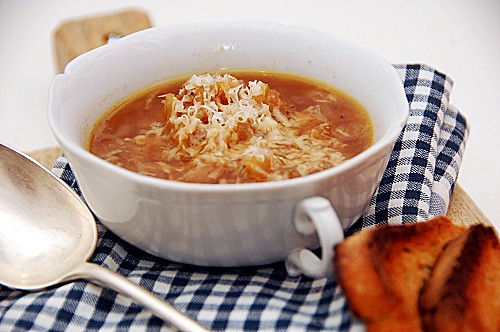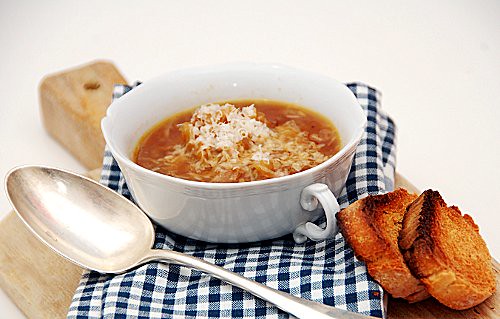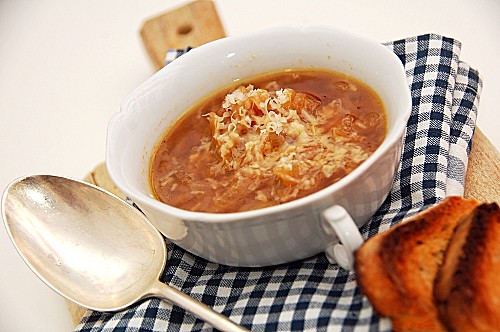With all that on this blog is always talking of books, I am not aware of ever having a shred of rece texts cooking. The reason is obvious: well-made series of reviews of these texts are to be found on the net and many food bloggers who take on the subject headings do so in a way that has nothing to envy to the professionals. We also have to write this argument would mean running the risk of overlap, with all the consequences of the case: and so, we turned to other things, comforted by the fact that, however, the blogosphere carry out this task in a more than excellent.
Epper, when Genny asked me to collaborate on G2Kitchen with a column on cookbooks, I have not hesitated to say yes: the space was right - a magazine for come on line in the Italian first-and perspective I agree. Do not reviews of new texts, but presentations of old books, according to a criterion which takes account of personal choice, however, the reliability of the recipes collected here. In other words, I should talk about the cookbooks that I loved most and which binds me a long and continuous visits, based on continuous consultations and prescriptions over the years have proved to be the real guarantee of success. How could I say no?
so I started doing the classic sorting of infallible, browsing the shelves of libraries all-my, first, and then those of my mother and my mother-in-law, and selecting fifty titles "without fail" From there I draw from time to time, with criteria that vary depending on the mood and what I'm running around but not affecting the result: more text is tested.
However, whenever I document. It 'a calamity from which I take on classical training, what makes me love notes in the margins most of the content and makes me dream about the bibliographies at the end of the book, which unfortunately does not stop even when faced with texts that I know virtually memory and does not require special skills or exegetical interpretation. But anyhow, I can not help it.
It must be said that so far I have found very little, except for usual, roaring back covers: with Escoffier, who knows what I'd imagined, and instead focused reviews little or nothing. But I never thought that the book made famous Julia Child was the subject of so little account here.
Against tens if not hundreds of reviews of films and numerous reworkings of the same recipes, in fact, the articles devoted to Mastering the Art of French Cooking is really count on the fingers of one hand. And it's a real shame, because if ever there is a book that deserves to be read and discussed and debated, it is this: not only for the completeness of the work, but also because, even before di essere un manuale che insegna a cucinare, è un esempio di come si dovrebbe scrivere un libro di cucina.
La nota garbatamente polemica è tutta qui- e cioè nel constatare l'abisso che separa i libri di nuova generazione- con una netta predominanza dell'immagine sul testo- da questo e da altri simili, di impianto "antico". A scanso di equivoci, io non ce l'ho con le fotografie, tutt'altro: le trovo un complemento importante, se non addirittura indispensabile, anche se nella misura in cui si mantengono fedeli alla finalità editoriale. Quello che lamento,semmai, è il venir meno della scrittura: a parte qualche eccezione, sono anni che leggo ricette raccontate in modo assolutamente piatto, incolore, boring. So we excite the images, texts as they leave us unmoved.
From my personal point of view, it's something unforgivable: not so much just because it is a cookbook, but also because, in this way, love the food does not pass anything. Not through writing, I mean, low to compile recipes with the same verve with a list dela spending.
The Child and her friends, however, were teachers, in all this skilful technique and passion in being able to transmit at the same time, as evidenced by the recipe for onion soup that I report below, in full translation. I apologize for the banality of choice these days of enforced absence from the kitchen, it is also up to you to settle for what is in the pantry. However, beyond the guaranteed success of the dish (at least ten years that I follow this recipe only), is the way you talk about the ingredients and the process of this soup to make their mark. So, make yourself comfortable, I translate.
so I started doing the classic sorting of infallible, browsing the shelves of libraries all-my, first, and then those of my mother and my mother-in-law, and selecting fifty titles "without fail" From there I draw from time to time, with criteria that vary depending on the mood and what I'm running around but not affecting the result: more text is tested.
However, whenever I document. It 'a calamity from which I take on classical training, what makes me love notes in the margins most of the content and makes me dream about the bibliographies at the end of the book, which unfortunately does not stop even when faced with texts that I know virtually memory and does not require special skills or exegetical interpretation. But anyhow, I can not help it.
It must be said that so far I have found very little, except for usual, roaring back covers: with Escoffier, who knows what I'd imagined, and instead focused reviews little or nothing. But I never thought that the book made famous Julia Child was the subject of so little account here.
Against tens if not hundreds of reviews of films and numerous reworkings of the same recipes, in fact, the articles devoted to Mastering the Art of French Cooking is really count on the fingers of one hand. And it's a real shame, because if ever there is a book that deserves to be read and discussed and debated, it is this: not only for the completeness of the work, but also because, even before di essere un manuale che insegna a cucinare, è un esempio di come si dovrebbe scrivere un libro di cucina.
La nota garbatamente polemica è tutta qui- e cioè nel constatare l'abisso che separa i libri di nuova generazione- con una netta predominanza dell'immagine sul testo- da questo e da altri simili, di impianto "antico". A scanso di equivoci, io non ce l'ho con le fotografie, tutt'altro: le trovo un complemento importante, se non addirittura indispensabile, anche se nella misura in cui si mantengono fedeli alla finalità editoriale. Quello che lamento,semmai, è il venir meno della scrittura: a parte qualche eccezione, sono anni che leggo ricette raccontate in modo assolutamente piatto, incolore, boring. So we excite the images, texts as they leave us unmoved.
From my personal point of view, it's something unforgivable: not so much just because it is a cookbook, but also because, in this way, love the food does not pass anything. Not through writing, I mean, low to compile recipes with the same verve with a list dela spending.
The Child and her friends, however, were teachers, in all this skilful technique and passion in being able to transmit at the same time, as evidenced by the recipe for onion soup that I report below, in full translation. I apologize for the banality of choice these days of enforced absence from the kitchen, it is also up to you to settle for what is in the pantry. However, beyond the guaranteed success of the dish (at least ten years that I follow this recipe only), is the way you talk about the ingredients and the process of this soup to make their mark. So, make yourself comfortable, I translate.
soupe a l'oignon
from Mastering the Art of French Cooking
from Mastering the Art of French Cooking
onions for onion soup need a long cooking over low heat, in oil or butter, followed by a slow sobbollitura nl stock, to enable them to develop that intense flavor and rich featuring a perfectly cooked. Roughly speaking, you should calculate two and a half hours from start to finish. Although the initial phase of cooking in butter requires some attention, you can proceed without having to monitor the sobbollitura
(My note: from these lines, we should take an example: the explanation is technical, the language is poetic. In three lines, You already know what to expect, time and type of cooking-but you already feel in the nose and palate, the goodness of this dish. If it is not skill, this ...)
for 6-8 servings
a pound and a half onion sliced \u200b\u200bthin (about 600 g)
1 ounce and a half of butter (about 50 g)
1 tablespoon oil
a thick-bottomed pan, with lid
Cook the onions slowly in the butter and oil in a saucepan with a lid, for 15 minutes
1 teaspoon salt
1 teaspoon sugar (helps the onions become brown)
Remove cover, raise the heat slightly and mix in salt and sugar. Bake 30 to 40 minutes, stirring frequently, until the onions have taken a uniform golden-brown color and intense
1 / 2 ounces of flour
Sprinkle the flour over the onions and stir for three minutes
1 and a half liters of boiling broth or 750 ml of boiling water and 750 ml of broth
120 ml dry white wine or dry white vermouth
salt and pepper
Outside fire, pour the hot liquid. Add wine and season, according to their taste. Simmer, partially covered for 30 or 40 minutes or more, schiumando di volta in volta. Aggiustare di sale
Mettere da parte fino al momento di servire. A quesl punto, riportare sul fuoco, al punto di ebollizione
3 cucchiai di cognac
crostini di pane francese ben tostati
da 100 a 200 g di parmigiano grattugiato
Prima di servire, versare il cognac nella zuppa. Versare in una zuppiera o in tazze individuali sopra crostini di pane e servire separatamente il formaggio
La ricetta prosegue poi con una serie di indicazioni, da how to prepare the croutons natures-version, version garlic & oil, and-cheese version with two variations, au gratin "simple" and "au gratin" deluxe "with the egg yolk, brandy and Worcester: all with the usual calm tone and the usual precision, giving rise to the reader the immediate desire to test themselves. If indeed the Child has been able to teach French cuisine to American home is just because it has instilled a passion for food, combined with the security in the run-and never mind if her series is bogged down with the mixes that are not stretched or with chickens that can not be cut: it is not the perfection that is sought: love for the kitchen, enough.
hello
ale
hello
ale



0 comments:
Post a Comment